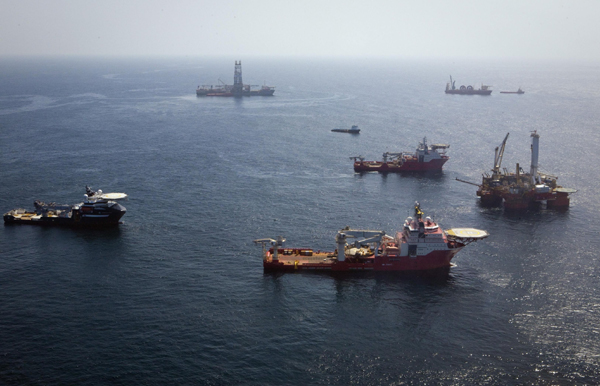BP plans 'static kill' procedure
British oil giant BP plans to start the "static kill" procedure to seal the blown-out well in the Gulf of Mexico on Tuesday, after a crucial test is conducted Monday to determine whether it will work, a senior BP official said.
 |
|
Support vessels sit at the site of the Deepwater Horizon oil disaster in the Gulf of Mexico off the Louisiana coast July 23, 2010. [Xinhua/Reuters File Photo] |
If the "injectivity test" conducted Monday shows crews are able to pump "base oil" down the ruptured well bore and back into a reservoir 13,000 feet below, BP will start the so-called "static kill" procedure to plug the leaking well once and for all sometime Tuesday, BP senior vice president Kent Wells said Monday.
The procedure would begin Tuesday and likely run into Wednesday, said Wells. In the "static kill," mud would be poured down into the well, possibly followed by cement.
The data gathered from the "injectivity test" would be analyzed Monday for officials to determine whether adjustments need to be made on "how and if" the "static kill" procedure will take place Tuesday, Wells said.
The "static kill" would be followed by a "bottom kill" after a relief well intercepts the underwater gusher, according to Wells.
However, he said, if the "injectivity test" failed, then the "static kill" would be skipped and the "bottom kill" would proceed.
After the deadly rig explosion on April 20 opened the gusher about 1.6 km under the Gulf of Mexico, hundreds of millions of liters of crude oil spewed into the sea before BP succeeded in sealing the leak in mid-July with a tight-fitting containment cap.
BP's incoming head Bob Dudley, who is currently in charge of the cleanup operations in the Gulf of Mexico, on Friday expressed confidence in the "static kill" process, saying "we are hopeful by Tuesday the static kill will have been performed."
Dudley was echoed by BP Chief Operating Officer Doug Suttles, who said Sunday "I do have a lot of confidence we will be successful."
However, U.S. Coast Guard Admiral Thad Allen, who is tasked to handle the oil spill, last week warned against elevated optimism. "We should not be writing any obituary for this event," he said.
Meanwhile, drilling relief wells remains the only sure way to seal the underwater gusher. The first of the two relief wells under construction is expected to be completed in August.
If the "static kill" succeeds, it will make it easier to finish the relief wells and also reduce the amount of mud needed to choke the oil for good, experts said.
 0
0 







Go to Forum >>0 Comments